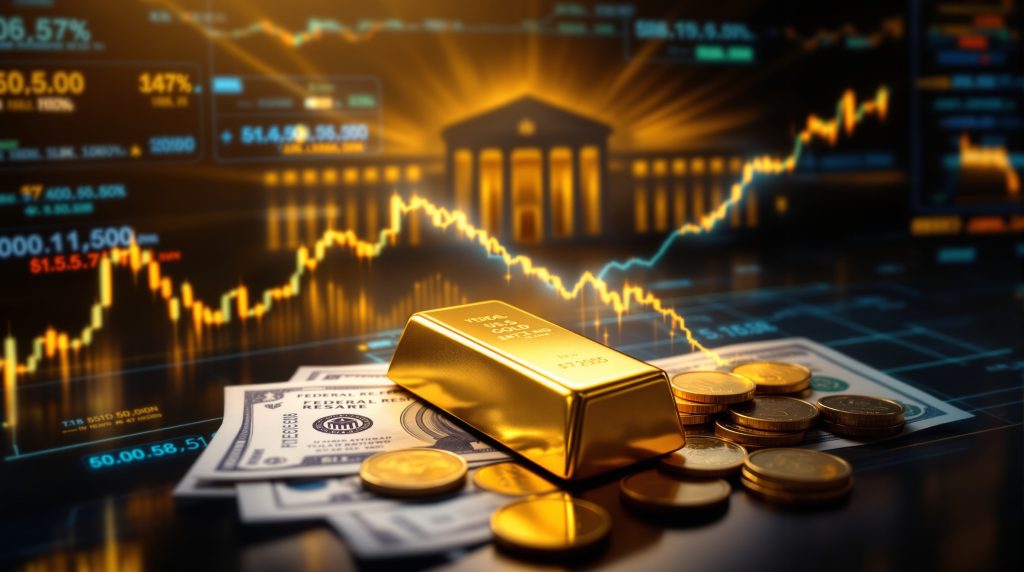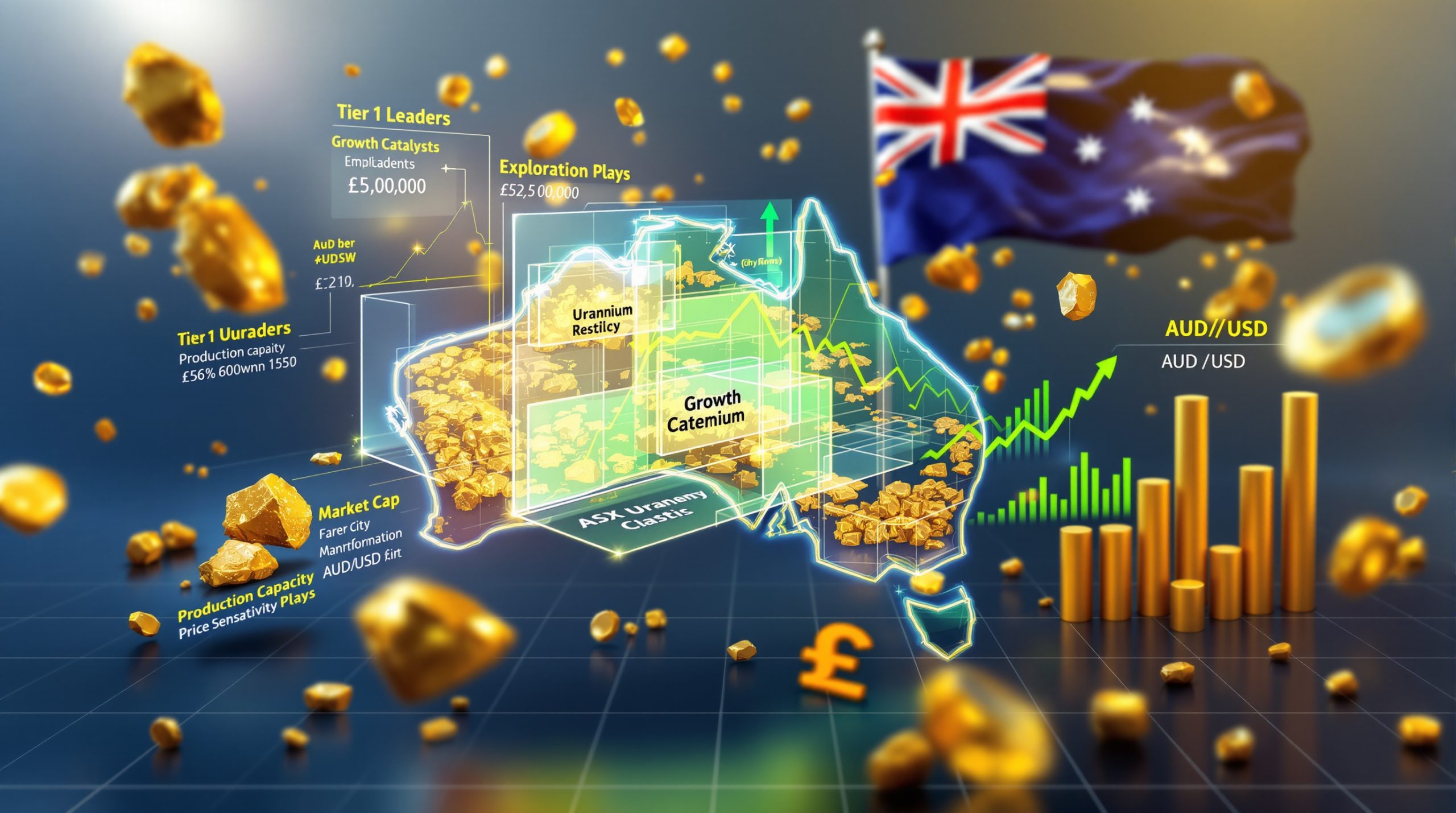Understanding the Gold-Interest Rate Relationship
The Fundamental Inverse Correlation
Gold and interest rates typically maintain an inverse relationship, with gold prices generally rising when interest rates fall. This connection stems from gold's unique status as a non-yielding asset that becomes comparatively more attractive when yields on interest-bearing investments decrease. According to the World Gold Council, this inverse correlation has historically shown correlation coefficients ranging from -0.5 to -0.8 during different market periods.
The fundamental economic principle behind this relationship is straightforward—when alternative investments offer lower yields, the opportunity cost of holding gold diminishes, making the precious metal more appealing to investors seeking to preserve capital.
The Economic Mechanism Behind Price Movements
When central banks cut interest rates, several economic forces activate simultaneously to influence gold prices:
- Returns on traditional savings accounts and bonds decrease substantially
- The opportunity cost of holding non-yielding assets like gold diminishes
- Investor capital shifts toward alternative stores of value for wealth preservation
- Currency values often adjust downward, affecting gold's relative pricing in various markets
This mechanism operates through a clear formula: Opportunity Cost = Risk-free rate – Gold storage/insurance costs. When rates approach zero or turn negative in real terms, this calculation increasingly favors gold allocation in investment portfolios.
Historical Performance During Rate Cut Cycles
Federal Reserve Economic Data shows that during previous rate-cutting cycles, gold has demonstrated consistent price appreciation:
- During the 2000-2003 rate cut cycle: Gold prices increased from approximately $280/oz to $400/oz, representing a 43% gain
- During the 2007-2009 financial crisis: Gold rose from around $650/oz to over $1,000/oz as rates fell to near zero
- During the 2019-2020 pre-pandemic cuts: Gold surged by approximately 35% as monetary policy loosened
These historical patterns demonstrate that rate cut environments have consistently provided favorable conditions for gold price forecast appreciation, though the magnitude varies based on economic circumstances, inflation expectations, and market sentiment.
What Happened to Gold After the Recent Fed Rate Cut?
Immediate Market Reaction
Following the Federal Reserve's 25 basis point rate cut, gold prices and interest rate cut effects demonstrated notable volatility but maintained their upward trajectory, with spot gold reaching new record levels. This marks gold's fifth consecutive weekly gain, highlighting the persistent strength in precious metals markets despite short-term price fluctuations.
The initial price action showed the classic pattern of "buy the rumor, sell the news" with some profit-taking following the actual announcement, but the underlying bullish trend quickly reasserted itself as markets digested the implications of the policy shift.
Analyst Perspectives on Current Pricing
Market experts remain bullish on gold's prospects despite short-term fluctuations. Market strategists have noted that gold prices analysis appears sustainable, with the bullish trend remaining intact and new highs appearing inevitable. Many financial analysts project gold could reach significantly higher levels before year-end, with some targets exceeding $4,000 per ounce.
Technical indicators, including momentum oscillators, moving averages, and relative strength metrics, continue to signal strong upward momentum in the gold market performance, supporting these bullish price projections.
Fed Communication Impact
The Federal Reserve's communication surrounding the rate cut created nuanced market reactions that influenced gold pricing:
- The central bank tempered the rate cut with warnings about persistent inflation concerns
- This mixed messaging initially created price volatility in precious metals markets
- Forward guidance from Federal Reserve officials suggested additional rate cuts might be forthcoming
- These forward-looking statements helped stabilize and strengthen gold's position after initial volatility
Market participants now appear focused on the anticipated path of monetary policy rather than the single rate cut itself, with gold prices reflecting expectations for further easing in the months ahead.
Why Do Interest Rate Cuts Boost Gold Prices?
The Opportunity Cost Factor
The opportunity cost mechanism represents the primary driver behind gold's price appreciation during rate cuts. According to research by the International Monetary Fund, a 1% decrease in real interest rates historically correlates with approximately 15-25% increase in gold prices over 12-month periods.
Lower interest rates reduce returns on interest-bearing assets through several channels:
- Bank deposit rates fall, reducing incentives for cash holdings
- Bond yields decline, making fixed income less attractive
- The relative disadvantage of holding non-yielding gold diminishes significantly
- Portfolio allocations shift toward hard assets as opportunity costs decline
This dynamic becomes particularly powerful when real interest rates turn negative, creating an environment where holding cash and bonds actually erodes purchasing power over time.
Real Interest Rates vs. Nominal Rates
The distinction between real and nominal interest rates plays a crucial role in gold pricing dynamics:
- Real interest rates = nominal rates minus inflation expectations
- Negative real rates create particularly favorable conditions for gold investment
- When inflation exceeds nominal rates, interest-bearing assets produce negative real returns
- Gold historically outperforms during negative real rate environments
The Fisher equation (Real rate = Nominal rate – Expected inflation) provides the mathematical foundation for understanding this relationship. Federal Reserve Bank of San Francisco research indicates gold acts as an especially effective inflation hedge when real rates fall below -2%.
Currency Devaluation Effects
Interest rate cuts often trigger currency adjustments that benefit gold prices through multiple mechanisms:
- Lower rates typically weaken the domestic currency against major trading partners
- Gold, priced in dollars globally, becomes less expensive for foreign buyers
- Increased international demand drives price appreciation in dollar terms
- Gold's status as a universal store of value strengthens during currency fluctuations
This currency effect can be particularly powerful during coordinated global monetary easing cycles, when multiple central banks are cutting rates simultaneously, supporting gold prices across different currency zones.
What Other Factors Are Currently Influencing Gold Prices?
Geopolitical Uncertainties
Beyond interest rates, several geopolitical factors continue to support gold's appeal as a safe-haven asset:
- Ongoing international conflicts create economic uncertainty and flight-to-safety demand
- Trade tensions between major economies remain unresolved, increasing market volatility
- Political transitions in key nations introduce policy uncertainties that favor risk hedging
- Regional instabilities threaten supply chains and economic stability globally
Academic research suggests these geopolitical factors can add a 5-10% premium to gold prices during crisis periods, with the VIX correlation with gold prices increasing to 0.4-0.6 during stress periods versus 0.1-0.2 during normal times.
Inflation Concerns
Inflation dynamics significantly impact gold's investment appeal through several channels:
- Current inflation levels remain above historical averages in many economies
- Consumer price expectations influence investment strategies and asset allocation
- Central banks' inflation-fighting credibility affects market confidence in paper currencies
- Gold traditionally serves as an inflation hedge during uncertain economic periods
Historical analysis shows gold's correlation with CPI increases rises significantly during periods when inflation exceeds 3% annually, with gold's beta to inflation expectations (measured by TIPS breakevens) averaging 0.6-0.8 during inflationary periods.
Central Bank Purchasing
Institutional buying patterns have shifted dramatically in recent years, creating additional support for gold prices:
- World Gold Council data shows central banks purchased 1,037 tonnes in 2022, the highest level since 1967
- Emerging market central banks accounted for 85% of official sector purchases
- Major central banks have accelerated gold purchases to diversify reserve assets
- Diversification away from dollar reserves continues as a strategic priority for many nations
This official sector buying represents a fundamental shift in the gold market structure, creating a significant source of demand that was largely absent during previous decades.
How Are Physical Gold Markets Responding?
Regional Premium Variations
Physical gold markets show interesting regional divergences that reflect local market conditions:
- Indian gold premiums have historically ranged from $5-15/oz above London spot prices
- Chinese discounts/premiums typically fluctuate between -$10 to +$20/oz depending on domestic demand
- Western markets generally maintain steady premium structures between spot and retail prices
- These variations reflect different cultural, economic, and seasonal factors affecting local demand
These premium variations provide important signals about the health of physical gold markets across different regions, with widening premiums indicating strong local demand relative to international prices.
Seasonal and Festival Demand
Seasonal factors continue to influence physical gold markets through well-established patterns:
- The festival season in India typically boosts gold demand by 25-40% during October-December
- Chinese New Year period (January-February) historically shows 15-30% demand increases
- Wedding season preparations contribute to sustained buying interest in many cultural contexts
- Jewelers report continued consumer interest despite elevated price points in many markets
These seasonal patterns create predictable demand cycles that influence price action, particularly in the physical markets where consumer buying habits follow cultural and traditional patterns.
Investment vs. Jewelry Demand
The balance between investment and consumer demand shows notable shifts that affect market dynamics:
- Investment demand currently dominates market dynamics in most regions
- Jewelry consumption has shown resilience despite high prices in traditional gold cultures
- Recycling volumes have increased but remain below previous peak periods
- Fabrication demand adjusts to price levels with significant regional variations
This shifting balance between investment and consumer demand influences price elasticity and market sensitivity to macroeconomic factors, with investment demand typically more responsive to interest rate and currency movements.
What's Happening with Other Precious Metals?
Silver's Performance
Silver has demonstrated strong performance alongside gold, reflecting its dual nature as both precious and industrial metal:
- The gold-silver ratio has historically averaged 65:1 over long-term periods but can range from 30:1 to 100:1
- Industrial demand supports silver's price through technological applications including solar panels and electronics
- Investment demand has increased as many view silver as an affordable alternative to gold
- Silver often exhibits higher volatility than gold, with larger percentage moves in both directions
This combination of industrial and investment demand creates unique price dynamics for silver compared to other precious metals, with potential for significant outperformance during strong bull markets.
Platinum Group Metals Trends
Platinum and palladium show divergent performance patterns based on their different industrial applications:
- Platinum: approximately 37% automotive, 31% jewelry, 20% industrial, 12% investment demand
- Palladium: dominated by automotive catalyst demand (over 80% of consumption)
- Industrial demand factors increasingly differentiate performance between these metals
- Automotive industry transitions affect demand projections for both metals
These different demand profiles create distinct price behaviors, with platinum historically maintaining a closer correlation to gold than palladium due to its stronger investment component.
Comparative Investment Appeal
The relative investment case across precious metals continues to evolve based on changing market conditions:
- Gold maintains its status as the premier precious metal investment for capital preservation
- Silver attracts attention for its relative affordability and potential leverage to gold price moves
- Platinum offers value propositions at current price ratios compared to historical averages
- Palladium faces challenges from automotive industry transitions toward electric vehicles
These comparative valuations influence investment flows between the metals, with relative value considerations often driving rotation between gold and the other precious metals during different market phases.
How Should Investors Approach Gold in a Rate-Cut Environment?
Portfolio Allocation Strategies
Effective gold investment strategies require thoughtful portfolio integration based on individual circumstances:
- Traditional allocation recommendations suggest 5-10% portfolio exposure as a baseline
- Current market conditions may warrant increased allocations for some investors
- Dollar-cost averaging can mitigate entry point risk during price volatility
- Rebalancing strategies become important as gold appreciates significantly
These allocation decisions should consider correlation benefits, as gold typically shows low or negative correlation with traditional financial assets during market stress periods, enhancing portfolio diversification.
Physical vs. Paper Gold Considerations
Investors must evaluate different gold investment vehicles based on their specific objectives:
- Physical gold: No counterparty risk, storage costs typically 0.5-1.5% annually, concerns about security and insurance
- Gold ETFs: Management fees range 0.25-0.60%, provide liquidity and convenience, but introduce counterparty considerations
- Mining stocks: Operational leverage to gold prices, but company-specific risks including management, geology, and jurisdiction
- Futures and options contracts: Capital efficiency but require active management and margin requirements
Each vehicle offers different risk-return characteristics, with physical gold providing the most direct exposure but also requiring solutions for secure storage and potential liquidity constraints.
Risk Management Approaches
Prudent risk management remains essential even in favorable environments for gold:
- Position sizing should reflect overall portfolio construction and risk tolerance
- Correlation benefits may diminish during extreme market stress periods
- Liquidity needs should influence physical vs. paper gold decisions
- Tax implications vary significantly between different gold investment vehicles
Investors should consider how gold fits within their broader financial plan, including time horizon, liquidity requirements, and tax circumstances, rather than viewing it in isolation.
What's the Outlook for Gold Prices Through Year-End?
Technical Price Projections
Technical analysis suggests continued strength in expected gold record prices through several indicators:
- Price momentum indicators remain in strongly positive territory across multiple timeframes
- Support levels have consistently held during temporary pullbacks, establishing higher lows
- Chart patterns suggest potential for further upside as consolidation phases resolve
- Volume indicators confirm strong participation in the uptrend across different market segments
These technical factors provide a framework for potential price targets, though fundamental drivers ultimately determine the sustainability of price advances.
Fed Policy Path Implications
The Federal Reserve's future policy decisions will significantly impact gold prices and interest rate cut relationships through several channels:
- Markets currently anticipate additional rate cuts in upcoming meetings
- The pace and magnitude of cuts will influence gold's trajectory and volatility
- Communication surrounding inflation concerns affects market expectations
- Terminal rate projections provide context for longer-term gold positioning
This policy path remains subject to economic data developments, particularly regarding inflation, employment, and growth metrics that influence central bank decision-making.
Year-End Price Targets
Analyst consensus points toward continued appreciation for gold prices, though with varying targets:
- Many analysts project potential for significant further gains by year-end
- Price targets assume continued monetary policy accommodation
- Geopolitical premium expectations remain embedded in forecasts
- Seasonal strength typically supports gold in the fourth quarter
These projections should be considered within the context of broader economic conditions, recognizing that gold bond market trends rarely follow linear paths and often include periods of consolidation and volatility.
FAQ: Gold and Interest Rate Relationships
How quickly do gold prices typically respond to interest rate cuts?
Gold prices often begin moving in anticipation of rate cuts, with the most significant price action occurring during the weeks preceding and following the actual policy change. Market expectations for future rate paths typically influence prices more than the immediate cut itself. This "forward-looking" nature of gold pricing means that price adjustments frequently begin 3-6 months before actual policy implementation, with traders positioning based on expected policy shifts rather than waiting for official announcements.
Do all types of interest rate cuts affect gold prices equally?
No. Unexpected or emergency rate cuts typically generate stronger gold price responses than widely anticipated policy adjustments. Additionally, cuts during economic stress periods often produce more dramatic gold price increases than those occurring during normal economic expansion. The context and messaging surrounding the cuts matter significantly, with cuts perceived as reactionary to economic weakness generating stronger gold price responses than those made proactively during healthy economic conditions.
How does gold perform when interest rates rise again?
While conventional wisdom suggests gold prices decline during rate hike cycles, historical data shows mixed results. Gold can perform well during rate increases if inflation rises faster than interest rates, maintaining negative real rates. Several rate hiking cycles have coincided with gold price appreciation when inflation expectations outpaced the increases in nominal rates. The market's perception of central banks' ability to control inflation through rate hikes also significantly influences gold's performance during tightening cycles.
Are there scenarios where gold prices might fall despite interest rate cuts?
Yes. If rate cuts are perceived as insufficient to address economic challenges, or if deflationary pressures emerge, gold prices could decline despite lower rates. Additionally, extreme market stress can temporarily pressure gold prices as investors liquidate positions to meet margin calls or raise cash. Liquidity crunches during financial crises can create short-term selling pressure across all asset classes, including gold, though these effects typically reverse once immediate liquidity needs are satisfied and safe-haven demand reasserts itself.
Ready to Profit from the Next Major Gold Rally?
Discover why significant interest rate cuts historically drive substantial gold price increases by exploring Discovery Alert's dedicated discoveries page at https://discoveryalert.com.au/discoveries/, where our proprietary Discovery IQ model identifies high-potential ASX mining opportunities before the broader market recognises them.




